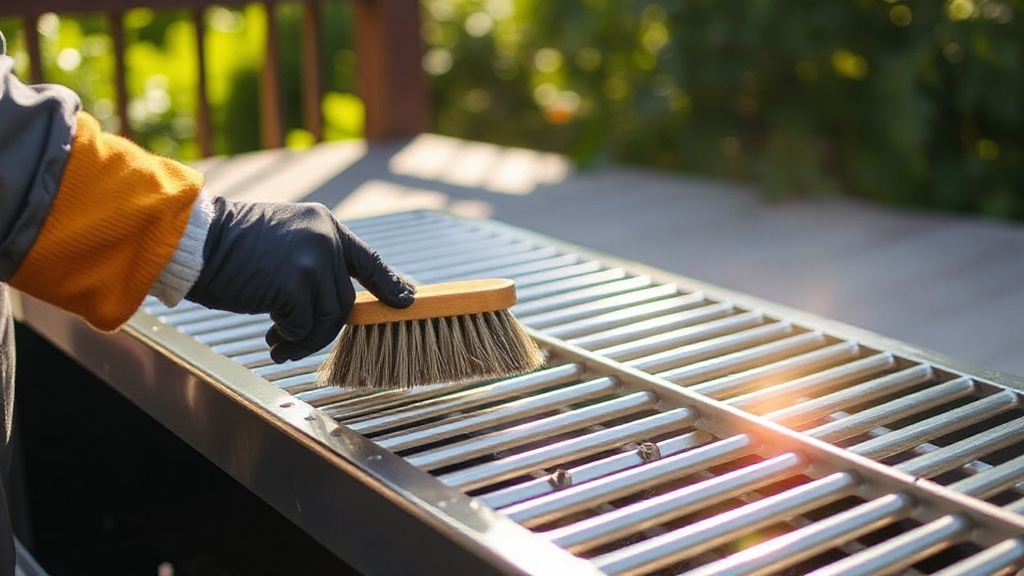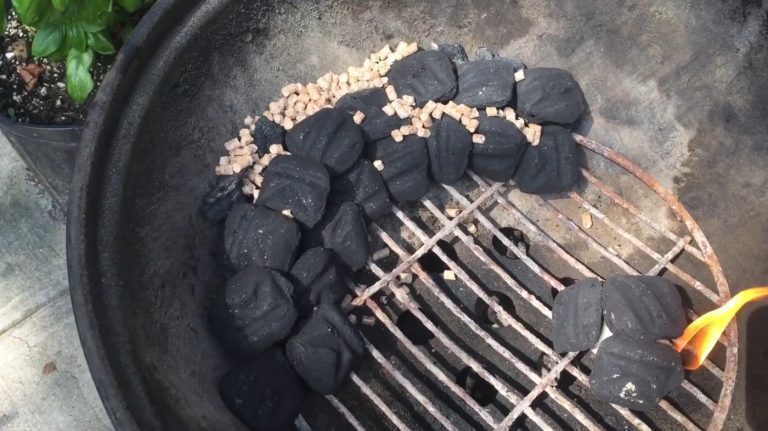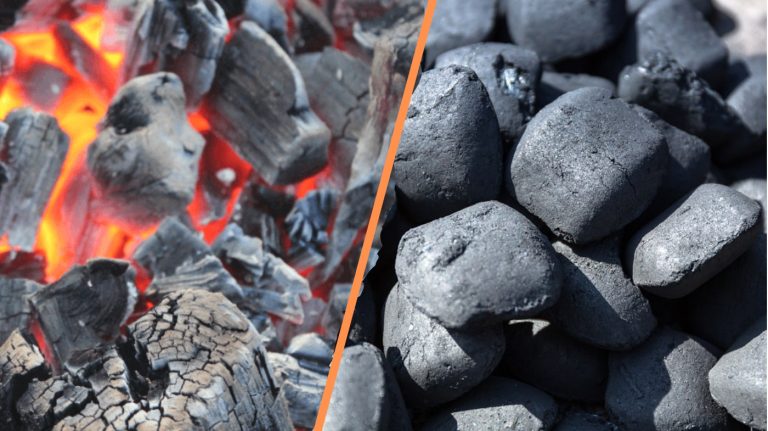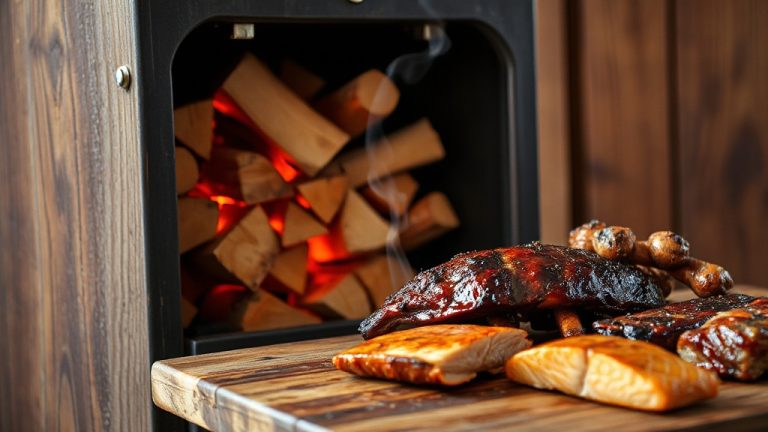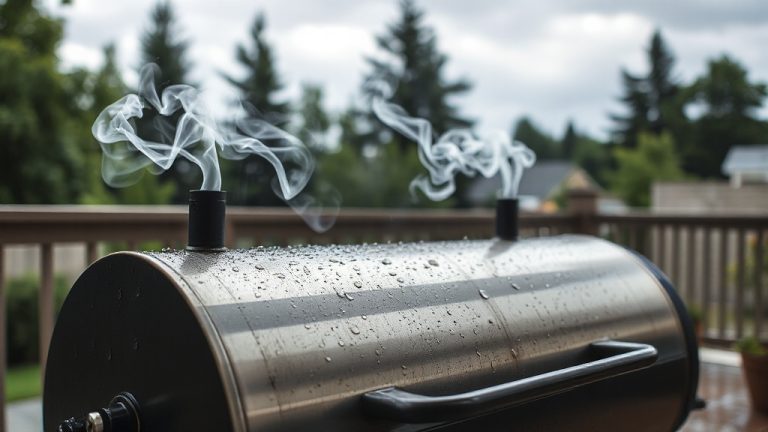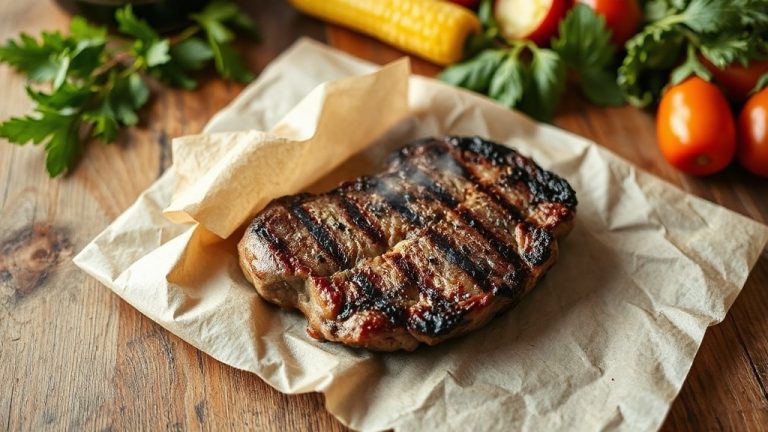How to Clean Stainless Steel Grill? Step-by-Step Guide
To clean your stainless steel grill, start by brushing hot grates with a stiff nylon or stainless steel brush after use, wearing heat-resistant gloves.
Use a baking soda paste or vinegar solution for tough stains, scrubbing gently along the grain. Rinse thoroughly and dry to prevent rust, then apply a thin layer of cooking oil to season and protect.
Regularly polish with a stainless steel cleaner and store the grill covered in a dry area to maintain its shine and longevity. There’s more to mastering grill care for ideal results.
Key Takeaways
- Clean grill grates immediately after use with a stiff nylon or stainless steel brush while still warm to remove residue and prevent buildup.
- Use a baking soda paste or vinegar solution to gently scrub and dissolve grease and stains, then rinse thoroughly and dry.
- Apply a thin layer of high-heat cooking oil after cleaning to season and protect stainless steel surfaces from moisture and rust.
- Avoid harsh abrasives; polish stainless steel with a soft microfiber cloth and food-safe stainless steel cleaner to maintain shine.
- Store the grill in a covered, dry area and use moisture-absorbing bags or covers to prevent rust and prolong grill lifespan.
Essential Materials for Cleaning Stainless Steel Grills
When you clean stainless steel grills, having the right materials is essential to protect the surface and guarantee effective results. Use baking soda paste for gentle scrubbing, and a vinegar solution (one part vinegar to three parts water) to remove stubborn grease and stains.
Lemon juice targets hard-to-reach greasy spots, while mild dish soap with warm water ensures a gentle clean. Specialty stainless steel cleaners handle tougher grime. Equip yourself with soft cloths or microfiber towels to avoid scratches and polish efficiently.
Non-abrasive sponges remove grime without damage, and grill brushes clear debris from grates. Wear cleaning gloves to shield your hands during tougher jobs, and consider grill bricks for gentle scrubbing. Before starting, ensure grill is cool to prevent accidents and protect materials.
Always clean along the grain to maintain the finish and avoid abrasive tools that could mar your grill’s surface.
Daily Cleaning Routine for Grill Grates
Although it might seem tedious, cleaning your grill grates immediately after each use is essential for maintaining their performance and longevity.
Cleaning grill grates right after use is key to keeping them in top shape and lasting longer.
While the grates are still hot, use a stiff nylon or stainless steel brush to remove food debris with quick, efficient strokes along the metal grain. This prevents buildup and reduces effort. Using gloves with heat resistance can protect your hands from burns during this step.
If you miss this step, preheat the grill to over 500°F before brushing. After scraping, rinse the grates with water and dry them thoroughly to avoid rust or water spots. Regular cleaning simplifies deep cleaning and prolongs grill usability.
Occasionally, apply a thin layer of high-heat cooking oil to season and protect the surface. Avoid harsh pads or brushes that can scratch stainless steel.
Techniques for Removing Tough Stains and Grease
You can tackle tough stains and grease on your stainless steel grill effectively using natural solutions like vinegar and baking soda.
Apply a baking soda paste to the affected areas and let it sit before scrubbing gently. Then use white vinegar or lemon juice to break down discoloration and residue.
These methods provide a powerful yet safe way to restore your grill’s surface without causing damage. It is important to always clean in the direction of the grain lines to prevent visible scratches and preserve the steel’s appearance.
For best results, ensure the grill is dry and well-ventilated before and after cleaning to prevent mold development.
Vinegar and Baking Soda
Since tough stains and grease can stubbornly cling to stainless steel grill grates, using a combination of vinegar and baking soda provides an effective, natural cleaning solution.
You can create a paste or soak grates overnight in a sealed bag with the mixture, allowing the foaming reaction to break down grime.
After treatment, gently scrub with a sponge or aluminum foil ball, avoiding excessive force to protect the stainless steel coating.
Proper maintenance like this extends grill lifespan and maintains optimal performance. Rinse thoroughly and dry to prevent rust.
It is also important to dry the grill thoroughly to prevent corrosion and moisture buildup, which can damage the metal over time.
| Method | Application | Key Tip |
|---|---|---|
| Soaking | Bag grates with vinegar & soda | Soak 8+ hours for best results |
| Paste | Brush paste on grates | Let sit 2 hours before scrubbing |
| Abrasive Scrub | Use crumpled aluminum foil | Test inconspicuous area first |
| Post-Cleaning | Dry and oil grates | Prevent rust and maintain non-stick |
Lemon Juice Applications
Building on the effectiveness of vinegar and baking soda, lemon juice offers another powerful natural solution for tackling tough stains and grease on stainless steel grills.
You can apply lemon halves directly onto greasy spots to loosen grime, letting the juice sit for a few minutes to maximize its grease-dissolving power.
This method utilizes household ingredients and avoids harsh chemicals, making it environmentally friendly. Additionally, lemon juice’s natural acidity complements the tangy brightness found in Maull’s BBQ Sauce, enhancing grill flavor when cleaning and preparing.
For rust or stubborn stains, mix lemon juice with cream of tartar to create a mild abrasive paste. Scrub this onto affected areas with a soft brush, then wipe clean to reveal rust-free surfaces.
Combining lemon juice with baking soda produces a bubbling reaction that softens burnt residues on grill grates.
Always rinse thoroughly and dry with a clean cloth afterward to prevent streaks and maintain your grill’s shine naturally and safely.
Safe Cleaning Products to Use on Stainless Steel
When selecting cleaning products for stainless steel grills, prioritizing formulas that are non-abrasive and food-safe guarantees effective grime removal without damaging the surface.
You should opt for water-based cleaners containing gentle oils and biodegradable ingredients, ensuring safety for both the grill and your health.
The Nuvera Stainless Steel Grill Cleaner, for example, contains a non-abrasive formula that protects surfaces with a thin, resistant coating. Avoid harsh abrasives or phosphates that can erode the protective finish.
Consider these safe options for your grill cleaning:
- Commercial non-abrasive cleaners like Nuvera Stainless Steel Grill Cleaner, which remove tough stains without scratching and leave a protective coating.
- Natural solutions such as vinegar-water mixtures or baking soda paste that effectively degrease and polish without toxins.
- Specialty kits designed for stainless steel surfaces that address stubborn stains and burnt grease safely.
Always use soft cloths and rinse thoroughly after cleaning to maintain the grill’s integrity and shine.
Preventing Rust and Damage on Your Grill
Although stainless steel grills resist corrosion better than other materials, you must take proactive steps to prevent rust and damage that can compromise their performance and appearance.
Always use a weatherproof grill cover to shield your grill from rain, snow, and dust, securing it tightly to prevent wind damage.
Store the grill in a dry, ventilated, and sheltered area to reduce moisture and UV exposure. Elevating the grill outdoors can help prevent moisture buildup and further reduce rust risk. Using porous materials in the surrounding area can help improve airflow and reduce trapped moisture.
After each use, wipe down and thoroughly dry grates, especially if you’ve cooked with acidic or salty foods.
Inspect your grill regularly for early signs of rust or pitting, and clean hidden crevices to eliminate grease buildup that traps moisture.
Avoid abrasive tools and polish metal surfaces with a microfiber cloth to maintain a protective barrier against oxidation. Using a stainless steel cleaner can also restore shine and reinforce this protective layer.
Using Specialized Tools and Cleaners Effectively
To clean your stainless steel grill thoroughly and safely, you need to use specialized tools and cleaners designed specifically for this purpose.
Start by selecting grill brushes with stainless steel bristles and comfortable handles to remove residue without scratching.
Incorporate steam cleaning tools to penetrate tough grime and sanitize without damaging surfaces. Use flat stainless steel scrapers to tackle caked-on grease gently.
- Preheat the grill slightly before using steam brushes to generate effective steam and loosen grime.
- Apply specialized stainless steel grill cleaners on cool grates, let sit briefly, then scrub or steam clean. Using clean fuel pellets in compatible smokers can reduce residue buildup, making cleanup easier.
- Regularly inspect brushes for loose bristles and replace them to prevent contamination. Many users find that using specialized grill cleaners significantly reduces cleaning time and effort.
Polishing and Maintaining the Shine of Your Grill
To keep your stainless steel grill looking its best, start by selecting a polish specifically designed for stainless steel to avoid damage.
Use soft microfiber cloths or buffers to apply the polish evenly, working it into the surface before buffing to a bright finish.
For larger surfaces, using a mini polisher with appropriate pads can significantly speed up the process and provide a more uniform shine.
Consistent polishing combined with regular cleaning and protective measures guarantees your grill maintains a long-lasting, flawless shine.
Additionally, maintaining proper temperature control during cleaning and use helps preserve the grill’s finish and performance.
Choosing the Right Polish
When selecting a polish for your stainless steel grill, you need one that not only cleans effectively but also safeguards the surface from future damage.
Choose a polish formulated specifically for grills to remove fingerprints, grease, and water marks while preserving the protective chromium oxide layer.
Maintaining the grill’s finish helps prevent buildup that could affect cooking, similar to how proper temperature management preserves the quality of Wagyu beef sliders’ fats during grilling.
Confirm it’s safe for food-contact surfaces and suitable for outdoor use, resisting heat and moisture exposure.
Look for these key features:
- Non-abrasive formula that cleans and protects in one step
- Easy application without sticky residues
- Compatibility with your preferred polishing method, whether manual or with tools
Popular options like Weber Stainless Steel Polish offer combined cleaning and protection with a pleasant scent, while Bar Keepers Friend excels at removing rust and stains, ideal for deeper restoration.
For those who prefer professional assistance, services like Leave Assembly to the Pros connect you with trusted experts who can also maintain and polish your grill to keep it in top condition.
Polishing Techniques and Tips
Although polishing stainless steel grills demands patience and careful preparation, mastering the techniques guarantees a flawless, mirror-like finish that enhances both appearance and durability.
Start by smoothing surfaces with progressively finer grits (150–1200) and remove dents or scratches beforehand. It is essential to avoid steel wool or abrasive tools that could damage the surface during cleaning and polishing.
For small areas, use hand polishing with a microfiber cloth and commercial polish; for larger grills, machine polishing with appropriate pads ensures uniform shine.
Target heat marks with specialized metal polish applied carefully. Always wipe polish residues thoroughly in the metal grain direction to prevent streaks.
Proper maintenance and avoiding materials that release toxic chemicals during use help preserve both the grill’s finish and safety.
| Technique | Key Tip |
|---|---|
| Hand Polishing | Use circular motions with microfiber cloth |
| Machine Polishing | Use wool or synthetic pads, avoid over-polishing |
| Heat Mark Removal | Apply metal polish gently, buff thoroughly |
Maintaining Long-Term Shine
Since maintaining the long-term shine of your stainless steel grill requires consistent care, you should perform weekly and post-grill cleanings using oil-based stainless steel cleaners like Weiman or Cerama Bryte.
Wipe down the surface in the direction of the grain to eliminate fingerprints, smudges, and buildup without streaks.
After each use, clean food residue with mild dish soap and warm water using a microfiber cloth. Using gentle, grain-friendly techniques prevents surface damage and keeps the finish reflective. To sustain the polished finish, incorporate these key practices:
- Apply a protective oil layer weekly to prevent rust and maintain luster.
- Conduct monthly deep cleans with specialty polishes like 3M Stainless Steel Cleaner & Polish to restore mirror-like shine.
- Schedule quarterly inspections and weather-proofing to guard against corrosion and environmental damage.
- Position your grill in a sheltered area when not in use to reduce exposure to wind and moisture, which helps preserve its finish.
Best Practices for Storing and Protecting Your Grill
Properly storing and protecting your stainless steel grill extends its lifespan and maintains ideal performance. Start by thoroughly cleaning the grill, removing food residue and grease, then rinse and dry completely to prevent water spots.
Thoroughly clean and dry your stainless steel grill to prolong its life and ensure top performance.
Store your grill in a covered area like a garage or shed to shield it from weather. Use moisture-absorbing bags inside to control condensation and place the grill on a mat to avoid rust on the bottom.
Wrap burner units in plastic bags to keep pests out, and apply a light coating of cooking oil on metal parts to repel moisture. Disconnect and store the gas tank safely outdoors.
Regularly inspect your grill for damage and clean burners before storage to ensure it functions at its best every grilling season.
Frequently Asked Questions
Can I Clean a Stainless Steel Grill if It’S Still Hot?
Yes, you can clean a stainless steel grill while it’s hot, and it’s actually recommended. Hot grates loosen food debris, making scrubbing more effective. Use a stainless steel or bristle-free brush designed for high temperatures, and always wear heat-resistant gloves to protect yourself.
Avoid abrasive tools to prevent scratches. Quick, efficient cleaning right after grilling helps maintain your grill’s performance and appearance, so don’t wait until it cools down.
How Often Should I Replace Grill Grates for Best Hygiene?
You should replace grill grates every 2 to 5 years, depending on usage and material quality. Stainless steel grates last longer but watch for rust, chips, or stubborn residue that won’t clean off—these signal it’s time for new grates.
Regular maintenance extends lifespan, but don’t ignore wear affecting cooking performance or hygiene. Prioritize replacing grates to guarantee even cooking, reduce bacterial buildup, and maintain food safety.
Is It Safe to Use Vinegar on Painted Stainless Steel Grills?
Using vinegar on painted stainless steel grills is a double-edged sword—you’ve got to handle it carefully. Vinegar’s acidity can dull or damage paint if left too long or used full strength.
Always dilute it with water, test on a hidden spot first, and avoid soaking. Apply with a soft cloth, rinse thoroughly, and dry immediately to protect the finish. For safer results, consider mild soap or specialized cleaners instead.
What’s the Best Way to Clean the Inside Drip Tray?
To clean the inside drip tray effectively, first remove it carefully to avoid spills. Soak it in warm, soapy water for at least 30 minutes to loosen grease.
Scrape off carbon buildup gently with a putty knife before scrubbing with a non-abrasive pad. Use a baking soda paste or a vinegar-water mix for stubborn stains. Rinse thoroughly and dry completely before reinstalling to prevent rust and maintain cleanliness.
Can Lemon Juice Damage the Stainless Steel Surface Over Time?
Imagine your stainless steel surface as a resilient shield, gleaming with a protective chromium oxide layer. Lemon juice, acidic yet gentle, acts like a sculptor’s tool, removing iron impurities and enhancing this armor.
You won’t see damage from occasional exposure, but continuous acid contact combined with abrasion might cause slight wear or discoloration. To keep your shield flawless, rinse promptly after use and avoid harsh scrubbing—preserving its strength and shine over time.
Keep Your Stainless Steel Grill Shining and Lasting Longer
Keeping your stainless steel grill clean not only enhances its appearance but also extends its lifespan—did you know regular maintenance can increase grill longevity by up to 50%?
By using the right materials, safe products, and consistent techniques, you’ll prevent rust and stubborn stains effectively.
Remember, polishing and storing your grill properly conserves its shine and functionality. Following these best practices ensures your grill stays in peak condition for every cookout, season after season.
